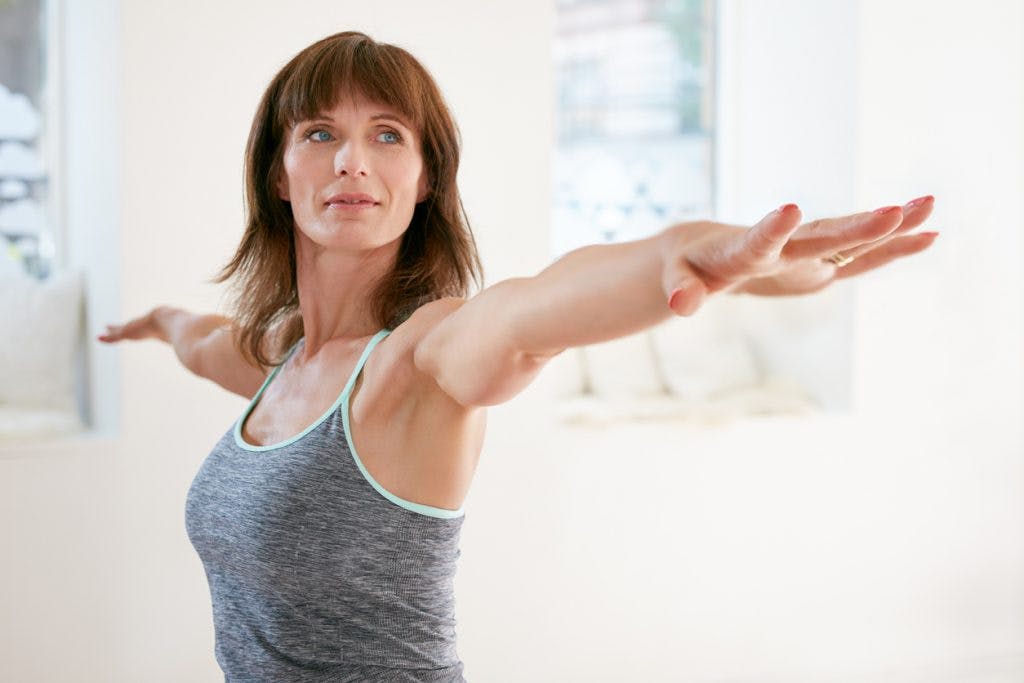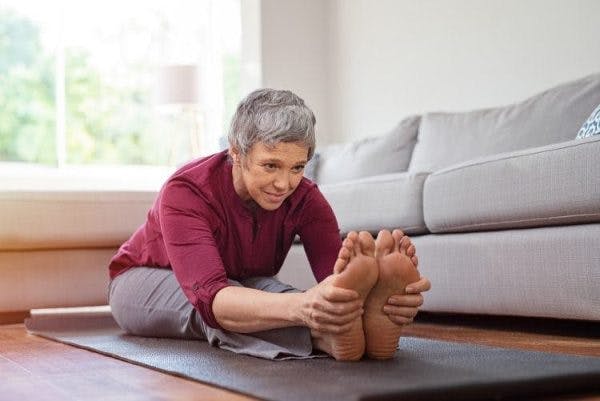Practicing balance exercises for brain injury patients is an excellent way to improve balance, as well as to promote independence and reduce the risk of falls. Balance exercises can range from simple beginner exercises to more challenging advanced-level activities.
While the exercises and activities described throughout this article can be a great starting point for brain injury survivors, working with physical and occupational therapists can help survivors learn more personalized exercises. Consistently practicing appropriately challenging balance exercises can stimulate adaptive changes in the brain, promoting recovery.
In this article, some of the best balance exercises for brain injury patients are described, starting with the easiest exercises and progressing to more advanced activities.
Use the links below to jump straight to any section:
- Benefits of Balance Exercises
- Balance Exercise Considerations
- Beginner Balance Exercises
- Intermediate Balance Exercises
- Advanced Balance Exercises
- Bonus: Tai Chi Balance Exercises
Benefits of Balance Exercises for Brain Injury Patients
Balance problems and dizziness are common secondary effects of traumatic brain injury, affecting somewhere between 23 and 81% of all survivors. Balance problems can impede independence and make it difficult to safely and effectively move around the home and community.
Furthermore, trouble with balance is a leading cause of falls. Falling after brain injury can result in further complications, delaying recovery. Therefore, it is essential for survivors to address balance impairments promptly.
One of the best ways to address balance problems is through therapeutic exercises and activities. Often recommended by a physical or occupational therapist, regular practice of balance exercises for brain injury patients can promote adaptive changes in the brain through a process called neuroplasticity.
This allows the brain to rewire itself so that healthy areas of the brain can assume control over functions that were affected by the injury. As survivors practice exercises and activities involving affected functions, the brain creates and strengthens the neural networks responsible for that function, promoting recovery.
Therefore, repetitively practicing balance exercises for brain injury patients can stimulate adaptive changes in the brain, resulting in improved balance abilities. The exercises below can help individuals begin to activate neuroplasticity for recovery.
Considerations Regarding Balance Exercises for Brain Injury Patients
During TBI rehabilitation, therapists recommend that individuals engage in exercises that are challenging but not frustrating. Therefore, it is important to find balance exercises that fit the survivor’s skill level.
Since these exercises may be challenging for those with balance impairments, it is essential to always consider one’s safety when exercising. Working closely with a therapist, trained caregiver or family member can help reduce the risk of falls.
If practicing balance exercises independently, consider holding onto a countertop or the back of a chair during exercises initially. As skills improve, take a step away, but stay within reach of stable support as a precaution.
Many individuals with balance impairments may use a cane or walker for stability. Although balance skills may improve with these exercises, it is important to consult with a physical therapist before transitioning to a less stable walking device.
Beginner Balance Exercises for Brain Injury Patients
The following are some beginner balance exercises for brain injury patients. If these do not provide a challenge, feel free to skip ahead to more advanced exercises.
1. Weight Shifts
Weight shifts are great beginner exercises for brain injury patients. Here’s how to practice them:
- Stand with your feet shoulder-width apart, with your weight equally distributed on both feet.
- Shift your weight to your right foot and lift your left foot slightly off the ground.
- Hold for as long as you can maintain good form, up to 30 seconds.
- Return to your starting position, then repeat on the other side.
- Repeat 5 times on each side. As your balance improves, you can increase the number of repetitions.
Remember that you can hold onto a stable object such as a countertop as needed initially. When you feel ready to stand without support, stay within reach of a stable support in case you need to catch your balance.
Watch the video below to see an example of this exercise:
2. Feet Apart, Arms Out
For this static balance exercise, stand with your feet shoulder-width apart, and stretch your arms all the way out to your sides to form a T-shape. Look straight ahead and hold your position for 30 seconds.
To increase the difficulty, try letting your arms rest down at your sides. For an even greater challenge, fold your arms across your chest and hold for 30 seconds.
Finally, for the greatest challenge, fold your arms across your chest and close your eyes. Hold for 30 seconds. However, make sure a trained caregiver or family member is with you as your eyes are closed to prevent injury.
3. Feet Together
These exercises are similar to the previous exercise, but instead of keeping your feet shoulder width apart, your feet will be together. As the feet get closer, your base of support gets smaller, challenging balance skills.
Bring the feet together until they are touching. Start with holding your arms straight out to either side, then gradually increase the difficulty by dropping your arms to your sides. To further challenge yourself, close your eyes. You can also try standing on something soft, like a pillow, to add a further challenge. Once again, have someone supervise you during this exercise to prevent injury.
Intermediate Balance Exercises for Brain Injury Patients
These exercises are a little more challenging than the ones above, so it is important to have someone nearby or stand near a stable support (such as a table) to prevent falls. If these are too challenging, continue to practice the beginner level exercises before progressing.
4. Feet Together, Turn Head
For this exercise, start by standing with your feet close together and your arms at your sides. (If you need to put your arms out, that’s okay too.) Next, you will turn your head all the way to the left, then back to center. Then turn your head to the right. Repeat 10 times.
5. Stand on One Leg (With Support)
While holding onto a support (such as the back of a chair or table) lift one leg. Hold for 30 seconds, then switch to the other leg. Progress to removing your hands from support for longer periods of time.
6. Stand on One Leg (No Support)
This will be the same as the last exercise, except this time the support is there just as a precaution. Standing near a stable support, like a table, relax your arms at your sides. Then lift one leg up from the ground, balancing on one foot for 30 seconds. Switch to the other foot and repeat.
7. Staggered Stance
Stand upright with one foot in front of the other. Your feet should both be facing forward, with the heel of your front foot touching the toe of your back foot. With your feet lined up, hold this position for 30-60 seconds. Then, switch the position of your feet, with the opposite foot in front. Close your eyes to add difficulty.
Below is another video to give you a visual of how your feet should be positioned:
8. Staggered Stance (with head movement)
Stand in the same position as the previous exercise. While in this stance, turn your head from left to right and back 10 times. Next, look up and down while still standing in a staggered stance. Repeat 10 times. Once again, if this feels too easy for you, close your eyes while moving your head to add difficulty.
For a video demonstration of all the exercises covered so far, plus a few bonus ones, take a look at the following video:
Advanced Balance Exercises for Brain Injury Patients
These balance exercises for brain injury patients involve more movement and coordination than the previous exercises. Because of this challenge, they can further improve your balance and walking abilities.
Once again, only attempt these exercises if you feel confident in your abilities. Make sure you always have someone with you for safety.
9. Staggered Stance (Eye Tracking)
Stand in a staggered stance, with one foot directly in front of the other (described above). Hold your finger about 10 inches in front of your face, and slowly move your finger straight up above your head and back down, keeping your eyes fixed on your finger at all times. Then move your finger from left to right. Keep following your finger’s movement with your eyes. Repeat 10 times.
For added difficulty, move your head up and down while following your finger with your eyes. Again, make sure a trained caregiver or family member is with you before doing this exercise.
10. Marching in Place
Stand with your feet slightly apart, then start marching in place by slowly lifting one knee up and then the other. Close your eyes to add difficulty.
11. Single Step Forward/Backward
Stand with your feet slightly apart. Lift your right foot off the floor and take one step forward. Move your foot back to its starting position, then take one step backwards and return again. Repeat with left leg. Do this 10 times.
12. Single Step Side to Side
Lift your right leg off floor, then take one step to the right. Return to the starting position, then repeat on the left side. Do this 10 times.
13. Swing One Leg Forward and Back
Stand on one foot, holding the other slightly lifted off the ground. Next, swing the lifted foot forward and backwards. Do this for 30 seconds, then switch to other foot. Repeat 10 times.
To increase difficulty, as your leg swings forward, swing your opposite arm back. As your leg swings back, swing your opposite arm forward. This requires greater coordination, and mimics the movements made while walking.
14. Swing One Leg Side to Side
Stand on one foot again. Then swing your other leg side to side, crossing the front of your body and then back out to the side. Do this for 30 seconds then switch to the other foot. Repeat 10 times.
15. Walking with Side-to-Side Head Motion
While walking straight forward, look to the right for 5 steps, then move your head back to center. Then repeat, turning your head to the left for 5 steps. Repeat 10 times.
Some of these exercises are particularly challenging, so only try them if you are looking to fine-tune your balance skills. Always remember to keep safety at the forefront, keeping a stable object within reach and/or having a family member or trained caregiver present to assist as needed.
For a good demonstration of a few of the advanced balance exercises described above, check out this video:
Tai Chi Balance Exercises for Brain Injury Patients
Another great form of exercise that can improve balance skills after brain injury is tai chi. This is a type of Chinese martial art that uses a series of slow, flowing motions and deep, slow breathing to calm the mind. These flowing movements can help strengthen and improve many of the physical components required to balance the body, such as leg strength, range of motion, and reflexes.
Furthermore, tai chi is also an effective way to acclimate to balancing in various positions. These skills can translate into helping survivors keep their balance when encountering rough or uneven pavement or getting stuck in a busy crowd.
Many health and fitness clubs and community centers offer tai chi classes for interested individuals, including TBI survivors. For those with severe balance impairments, seated tai chi may be appropriate to promote moving and strengthening the body.
Practicing Balance Exercises for Brain Injury Patients
Practicing balance exercises for brain injury patients can help individuals recover their balance to increase their safety and independence in daily life. Consistently practicing these exercises, ideally every day, is optimal to promote adaptive brain rewiring through neuroplasticity.
As balance skills improve, individuals can progress from beginner exercises to more advanced exercises. However, it is essential to always consider safety measures when practicing these exercises to ensure a fall does not occur. Talk with your therapist for more specific and customized exercises.









